北师大版(2019)必修 第二册Unit 5 Humans and nature Lesson 2 Professional Rescue Team课件(共18张PPT)
文档属性
| 名称 | 北师大版(2019)必修 第二册Unit 5 Humans and nature Lesson 2 Professional Rescue Team课件(共18张PPT) | 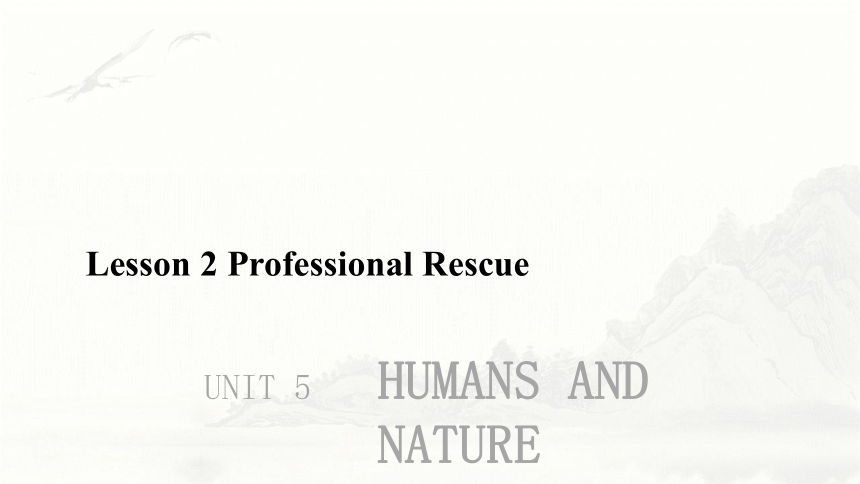 | |
| 格式 | pptx | ||
| 文件大小 | 7.2MB | ||
| 资源类型 | 教案 | ||
| 版本资源 | 北师大版(2019) | ||
| 科目 | 英语 | ||
| 更新时间 | 2024-03-26 09:49:00 | ||
图片预览

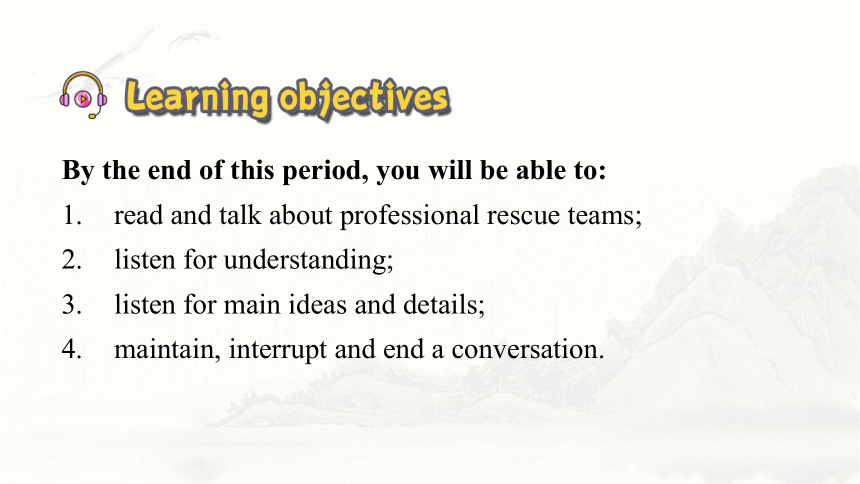
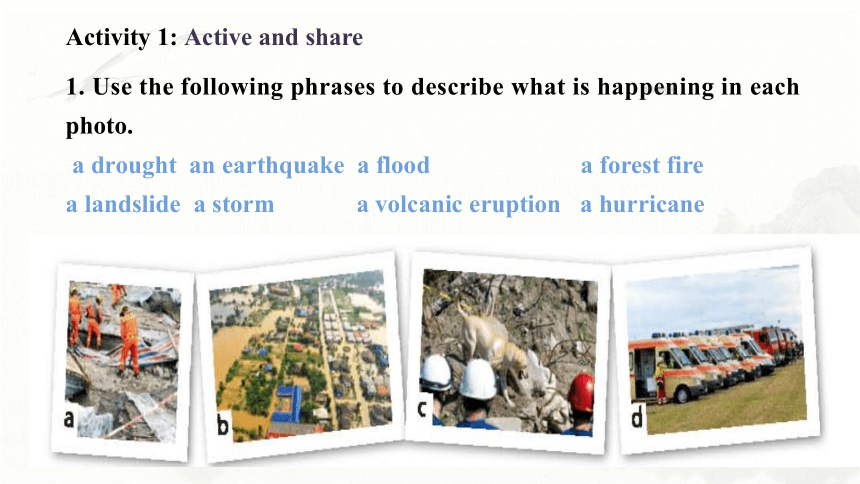
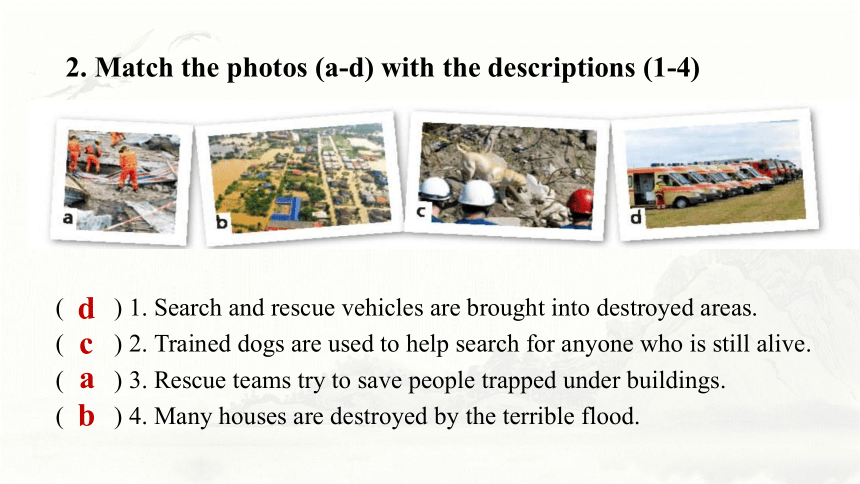
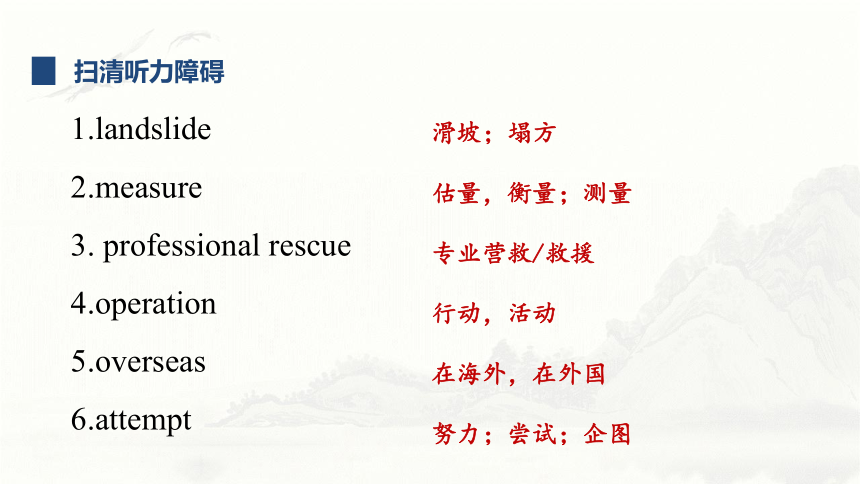
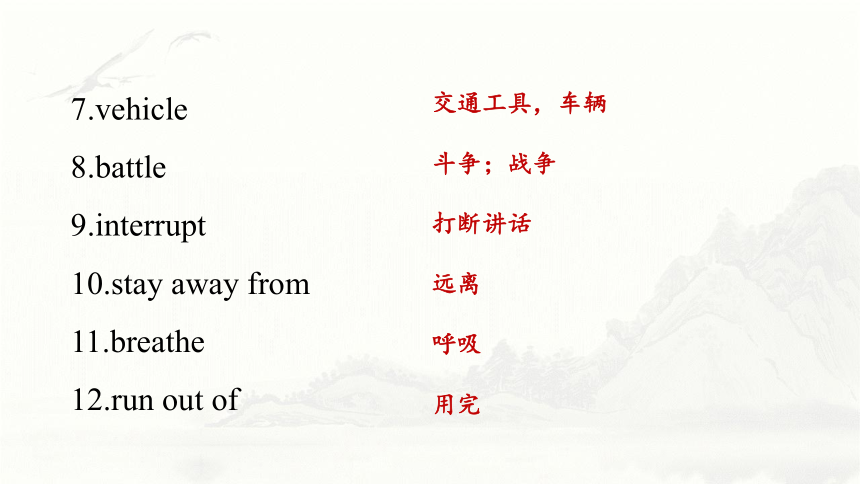
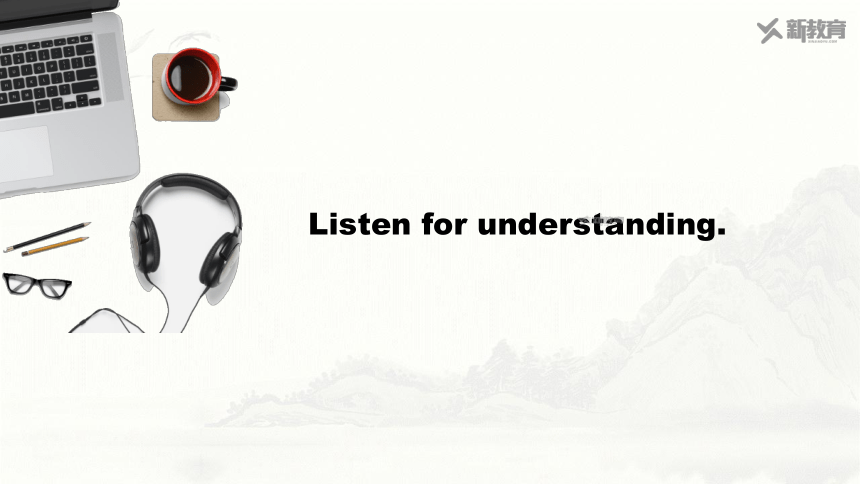
文档简介
(共18张PPT)
Lesson 2 Professional Rescue
UNIT 5
HUMANS AND NATURE
By the end of this period, you will be able to:
read and talk about professional rescue teams;
listen for understanding;
listen for main ideas and details;
maintain, interrupt and end a conversation.
1. Use the following phrases to describe what is happening in each photo.
a drought an earthquake a flood a forest fire
a landslide a storm a volcanic eruption a hurricane
Activity 1: Active and share
2. Match the photos (a-d) with the descriptions (1-4)
( ) 1. Search and rescue vehicles are brought into destroyed areas.
( ) 2. Trained dogs are used to help search for anyone who is still alive.
( ) 3. Rescue teams try to save people trapped under buildings.
( ) 4. Many houses are destroyed by the terrible flood.
b
d
c
a
扫清听力障碍
1.landslide
2.measure
3. professional rescue
4.operation
5.overseas
6.attempt
滑坡;塌方
估量,衡量;测量
专业营救/救援
行动,活动
在海外,在外国
努力;尝试;企图
7.vehicle
8.battle
9.interrupt
10.stay away from
11.breathe
12.run out of
交通工具,车辆
斗争;战争
打断讲话
远离
呼吸
用完
Listen for understanding.
Listen for Main Ideas and Details
Main ideas are the key points of a presentation or a talk. They are supported by details.
When you listen, pay close attention to the statement that is emphasised by the speaker (usually at the beginning and end of the talk). This is often the main idea.
Listen carefully for key words, phrases and ideas that are repeated. These will confirm the main idea.
Now listen for specific information that supports the main ideas, e.g. examples, causes, reasons, facts and descriptions. These are the details.
Skill Builder
Activity 2: Listen to the first part of the interview. Answer the questions.
1. What is the interview about
2. Who is the interviewee
3. Which two disasters are mentioned
It is about what __________________________ do when a natural disaster happens.
professional rescue teams
Mr Wang, who is from China International Search and Rescue Team.
the Wenchuan earthquake, the Nepal earthquake
Activity 3: Listen again. Complete the sentences. Then decide if the sentences contain a main idea (MI) about rescue attempts or a detail (D). Write the correct letter in the brackets.
1. Our first and most important goal is to __________. ( )
2. We use __________________ vehicles and _____________ to look for anyone who is still alive. ( )
3. In a rescue attempt during the Nepal earthquake:
Over ______ members and ____ dogs took part, and we were there for ______ days. ( )
We rescued ________ people and provided medical help to over _______ people. ( )
4. It’s our duty to try to reduce _________ and _____________. ( )
save lives
MI
search and rescue
trained dogs
D
sixty
six
twelve
D
two
2,000
D
suffering
the loss of life
MI
Activity 4: Pair Work Work out four questions you may ask according to the information you heard in Activity 2. Then ask and answer the questions.
1. What is the most important goal of search and rescue attempts
2. How do rescue teams search for people who might be alive
The first and most important goal is to save lives.
They use search and rescue vehicles and trained dogs to look for anyone who is still alive.
3. Who took part in the rescue attempt in Nepal after the earthquake
How many people did they help
4. What is Mr Wang’s attitude towards his job Support your answer with evidence from the interview.
Over sixty members and six dogs took part, and they were there for twelve days.
They rescued two people and provided medical help to over 2,000 people.
He is devoted to his duty.
It’s our duty to try our best to reduce suffering and the loss of life.
We’re trained to do so.
Focus on function:
Maintaining, interrupting and ending a conversation.
Activity 5: Listen to the second part of the interview and fill in the form.
Outdoors Indoors Trapped
_________________ _____from any build-ings or streetlights. _____________ anything that can break or fall. _____________ to help people find you and _________ when someone is nearby.
Stay there and move away
Stay away from
Knock on a wall
only shout
2. What is mainly talked about in the dialogue
A. How to conduct rescue attempts.
B. What to do in an earthquake.
C. Where to go during disasters.
√
Maintaining, Interrupting and Ending a Conversation
1. Excuse me, Mr Wang, but can I interrupt you there ( )
2. OK, if I’m outdoor, ... ( )
3. Sorry, but my advice is to... ( )
4. Sorry for interruption again... ( )
5. Well, I’d love to know more, but, unfortunately, we’ve run out of time. ( )
6. So, I’m very sorry, but we’ll have to finish there. ( )
Talk Builder
I
M
I
Activity 6: Listen again. Decide whether the phrases in italics are used to : maintain (M), interrupt (I) or end (E) a conversation. Write the correct letter in the brackets.
I
E
E
Activity 7:What are polite ways to maintain, interrupt and end a conversation Can you find more expressions
1. To maintain a conversation
May I ask why...
Why do you think that...
I like it.What do you think
2.To interrupt a conversation
Would you mind if I joined the conversation
Sorry for the interruption but could you repeat...
I’m sorry for interrupting but I don’t quite understand.
3.To end a conversation
Well, it’s been nice talking to you, but I really have to go.
I’m really sorry but I’ve got a lot of work to do right now.
I won’t keep you any longer.
Activity 8: Pair Work Practise maintaining, interrupting and ending a conversation in the following situations. Use the expressions in the Talk Builder to help you.
Situation 1: Two friends talking on the phone.
Friend 1: talking about his /her worries for the next day’s presentation
Friend 2: needs to end the conversation so as to catch a train
Situation 2: An English teacher and a student in an English class
English teacher: explaining how to use relative clauses
Student: needs to interrupt so as to ask a question
本课结束
Lesson 2 Professional Rescue
UNIT 5
HUMANS AND NATURE
By the end of this period, you will be able to:
read and talk about professional rescue teams;
listen for understanding;
listen for main ideas and details;
maintain, interrupt and end a conversation.
1. Use the following phrases to describe what is happening in each photo.
a drought an earthquake a flood a forest fire
a landslide a storm a volcanic eruption a hurricane
Activity 1: Active and share
2. Match the photos (a-d) with the descriptions (1-4)
( ) 1. Search and rescue vehicles are brought into destroyed areas.
( ) 2. Trained dogs are used to help search for anyone who is still alive.
( ) 3. Rescue teams try to save people trapped under buildings.
( ) 4. Many houses are destroyed by the terrible flood.
b
d
c
a
扫清听力障碍
1.landslide
2.measure
3. professional rescue
4.operation
5.overseas
6.attempt
滑坡;塌方
估量,衡量;测量
专业营救/救援
行动,活动
在海外,在外国
努力;尝试;企图
7.vehicle
8.battle
9.interrupt
10.stay away from
11.breathe
12.run out of
交通工具,车辆
斗争;战争
打断讲话
远离
呼吸
用完
Listen for understanding.
Listen for Main Ideas and Details
Main ideas are the key points of a presentation or a talk. They are supported by details.
When you listen, pay close attention to the statement that is emphasised by the speaker (usually at the beginning and end of the talk). This is often the main idea.
Listen carefully for key words, phrases and ideas that are repeated. These will confirm the main idea.
Now listen for specific information that supports the main ideas, e.g. examples, causes, reasons, facts and descriptions. These are the details.
Skill Builder
Activity 2: Listen to the first part of the interview. Answer the questions.
1. What is the interview about
2. Who is the interviewee
3. Which two disasters are mentioned
It is about what __________________________ do when a natural disaster happens.
professional rescue teams
Mr Wang, who is from China International Search and Rescue Team.
the Wenchuan earthquake, the Nepal earthquake
Activity 3: Listen again. Complete the sentences. Then decide if the sentences contain a main idea (MI) about rescue attempts or a detail (D). Write the correct letter in the brackets.
1. Our first and most important goal is to __________. ( )
2. We use __________________ vehicles and _____________ to look for anyone who is still alive. ( )
3. In a rescue attempt during the Nepal earthquake:
Over ______ members and ____ dogs took part, and we were there for ______ days. ( )
We rescued ________ people and provided medical help to over _______ people. ( )
4. It’s our duty to try to reduce _________ and _____________. ( )
save lives
MI
search and rescue
trained dogs
D
sixty
six
twelve
D
two
2,000
D
suffering
the loss of life
MI
Activity 4: Pair Work Work out four questions you may ask according to the information you heard in Activity 2. Then ask and answer the questions.
1. What is the most important goal of search and rescue attempts
2. How do rescue teams search for people who might be alive
The first and most important goal is to save lives.
They use search and rescue vehicles and trained dogs to look for anyone who is still alive.
3. Who took part in the rescue attempt in Nepal after the earthquake
How many people did they help
4. What is Mr Wang’s attitude towards his job Support your answer with evidence from the interview.
Over sixty members and six dogs took part, and they were there for twelve days.
They rescued two people and provided medical help to over 2,000 people.
He is devoted to his duty.
It’s our duty to try our best to reduce suffering and the loss of life.
We’re trained to do so.
Focus on function:
Maintaining, interrupting and ending a conversation.
Activity 5: Listen to the second part of the interview and fill in the form.
Outdoors Indoors Trapped
_________________ _____from any build-ings or streetlights. _____________ anything that can break or fall. _____________ to help people find you and _________ when someone is nearby.
Stay there and move away
Stay away from
Knock on a wall
only shout
2. What is mainly talked about in the dialogue
A. How to conduct rescue attempts.
B. What to do in an earthquake.
C. Where to go during disasters.
√
Maintaining, Interrupting and Ending a Conversation
1. Excuse me, Mr Wang, but can I interrupt you there ( )
2. OK, if I’m outdoor, ... ( )
3. Sorry, but my advice is to... ( )
4. Sorry for interruption again... ( )
5. Well, I’d love to know more, but, unfortunately, we’ve run out of time. ( )
6. So, I’m very sorry, but we’ll have to finish there. ( )
Talk Builder
I
M
I
Activity 6: Listen again. Decide whether the phrases in italics are used to : maintain (M), interrupt (I) or end (E) a conversation. Write the correct letter in the brackets.
I
E
E
Activity 7:What are polite ways to maintain, interrupt and end a conversation Can you find more expressions
1. To maintain a conversation
May I ask why...
Why do you think that...
I like it.What do you think
2.To interrupt a conversation
Would you mind if I joined the conversation
Sorry for the interruption but could you repeat...
I’m sorry for interrupting but I don’t quite understand.
3.To end a conversation
Well, it’s been nice talking to you, but I really have to go.
I’m really sorry but I’ve got a lot of work to do right now.
I won’t keep you any longer.
Activity 8: Pair Work Practise maintaining, interrupting and ending a conversation in the following situations. Use the expressions in the Talk Builder to help you.
Situation 1: Two friends talking on the phone.
Friend 1: talking about his /her worries for the next day’s presentation
Friend 2: needs to end the conversation so as to catch a train
Situation 2: An English teacher and a student in an English class
English teacher: explaining how to use relative clauses
Student: needs to interrupt so as to ask a question
本课结束
同课章节目录
- Unit 4 Information technology
- Lesson 1 Avatars
- Lesson 2 Apps
- Lesson 3 Internet and Friendships
- Unit 5 Humans and nature
- Lesson 1 A Sea Story
- Lesson 2 Professional Rescue Team
- Lesson 3 Race to the Pole
- Unit 6 The admirable
- Lesson 1 A Medical Pioneer
- Lesson 2 History Makers
- Lesson 3 The Superhero Behind Superman
